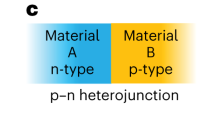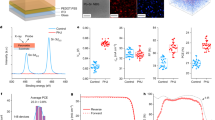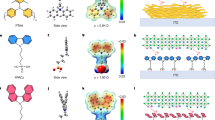Abstract
An inverted bulk heterojunction perovskite–PCBM solar cell with a high fill factor of 0.82 and a power conversion efficiency of up to 16.0% was fabricated by a low-temperature two-step solution process. The cells exhibit no significant photocurrent hysteresis and their high short-circuit current density, fill factor and efficiency are attributed to the advantageous properties of the active layer, such as its high conductivity and the improved mobility and diffusion length of charge carriers. In particular, PCBM plays a critical role in improving the quality of the light-absorbing layer by filling pinholes and vacancies between perovskite grains, resulting in a film with large grains and fewer grain boundaries.
This is a preview of subscription content, access via your institution
Access options
Subscribe to this journal
Receive 12 print issues and online access
$209.00 per year
only $17.42 per issue
Buy this article
- Purchase on Springer Link
- Instant access to full article PDF
Prices may be subject to local taxes which are calculated during checkout





Similar content being viewed by others
References
Kojima, A., Teshima, K., Shirai, Y. & Miyasaka, T. Organometal halide perovskites as visible-light sensitizers for photovoltaic cells. J. Am. Chem. Soc. 131, 6050–6051 (2009).
Best Research Cell Efficiency (NREL); http://www.nrel.gov/ncpv/images/efficiency_chart.jpg (2015).
Zhou, H. et al. Planar heterojunction perovskite solar cells via vapor-assisted solution process. Science 345, 542–546 (2014).
Lee, M. M., Teuscher, J., Miyasaka, T., Murakami, T. N. & Snaith, H. J. Efficient hybrid solar cells based on meso-superstructured organometal halide perovskites. Science 338, 643–647 (2012).
You, J. et al. Low-temperature solution-processed perovskite solar cells with high efficiency and flexibility. ACS Nano 8, 1674–1680 (2014).
Burschka, J. et al. Sequential deposition as a route to high-performance perovskite-sensitized solar cells. Nature 499, 316–320 (2013).
Liu, M., Johnston, M. B. & Snaith, H. J. Efficient planar heterojunction perovskite solar cells by vapor deposition. Nature 501, 395–398 (2013).
Xiao, Z. et al. Efficient, high yield perovskite photovoltaic devices grown by inter-diffusion of solution-processed precursor stacking layers. Energy Environ. Sci. 7, 2619–2623 (2014).
Zhou, H. et al. Photovoltaics: interface engineering of highly efficient perovskite solar cells. Science 345, 542–546 (2014).
Jeon, N. J. et al. Solvent engineering for high-performance inorganic–organic hybrid perovskite solar cells. Nature Mater. 13, 897–903 (2014).
Yang, W. S. et al. High-performance photovoltaic perovskite layers fabricated through intramolecular exchange. Science 348, 1234–1237 (2015).
Mitzi, D. B. Synthesis, structure, and properties of organic-inorganic perovskites and related materials. Prog. Inorg. Chem. 48, 1–121 (2007).
Eperon, G. E., Burlakov, V. M., Docampo, P., Goriely, A. & Snaith, H. J. Morphological control for high performance, solution-processed planar heterojunction perovskite solar cells. Adv. Funct. Mater. 24, 151–157 (2014).
Chiang, C.-H., Tseng, Z.-L. & Wu, C.-G. Planar heterojunction perovskite/ PC71BM solar cells with enhanced open-circuit voltage via (2/1)-step spin- coating process. J. Mater. Chem. A 2, 15897–15903 (2014).
Wu, C.-G. et al. High efficiency stable inverted perovskite solar cells without current hysteresis. Energy Environ. Sci. 8, 2725-2733 (2015).
Yang, B. et al. Perovskite solar cells with near 100% internal quantum efficiency based on large single crystalline grains and vertical bulk heterojunctions. J. Am. Chem. Soc. 137, 9210–9213 (2015).
Lin, Q., Armin, A., Nagiri, R. C. R., Burn, P. L. & Meredith, P. Electro-optics of perovskite solar cells. Nature Photon. 9, 106–112 (2015).
Park, N.-G. Organometal perovskite light absorbers toward a 20% efficiency low cost solid-state mesoscopic solar cell. J. Phys. Chem. Lett. 4, 2423–2429 (2013).
McGehee, M. D. Materials science: fast-track solar cells. Nature 501, 323–325 (2013).
Kazim, S., Nazeeruddin, M. K., Grätzel, M. & Ahmad, S. Perovskite as light harvester: A game changer in photovoltaics. Angew. Chem. Int. Ed. 53, 2812–2824 (2014).
Hodes, G. & Cahen, D. Perovskite cells roll forward. Nature Photon. 8, 87–99 (2014).
Docampo, P., Ball, J. M., Darwich, M., Eperon, G. E. & Snaith, H. J. Efficient organometal trihalide perovskite planar-heterojunction solar cells on flexible polymer substrates. Nature Commun. 4, 2761 (2014).
D'Innocenzo, V. et al. Excitons versus free charges in organo-lead tri-halide perovskites. Nature Commun. 5, 3586 (2014).
Heo, J. H., Han, H. J., Kim, D., Ahn, T. K. & Im, S. H. 18.1% hysteresis-less inverted CH3NH3PbI3 planar perovskite hybrid solar cells. Energ. Environ. Sci. 8, 1602–1608 (2015).
Dong, Q. et al. Electron-hole diffusion lengths >175 μm in solution-grown CH3NH3PbI3 single crystals. Science 347, 967–970 (2015).
Wang, X. et al. Transient photocurrent and photovoltage studies on charge transport in dye sensitized solar cells made from the composites of TiO2 nanofibers and nanoparticles. Appl. Phys. Lett. 98, 082114 (2011).
Xiao, Z. et al. Solvent annealing of perovskite-induced crystal growth for photovoltaic device efficiency enhancement. Adv. Mater. 26, 6503–6509 (2014).
O'Regan, B. C., Scully, S., Mayer, A., Palomares, E. & Durrant, J. The effect of Al2O3 barrier layers in TiO2/Dye/CuSCN photovoltaic cells explored by recombination and DOS characterization using transient photovoltage measurements. J. Phys. Chem. B 109, 4616–4623 (2005).
Snaith, H. J. et al. Efficiency enhancements in solid-state hybrid solar cells via reduced charge recombination and increased light capture. Nano Lett. 7, 3372–3376 (2007).
Nakade, S., Kambe, S., Kitamura, T., Wada, Y. & Yanagida, S. Effects of lithium ion density on electron transport in nanoporous TiO2 electrodes. J. Phys. Chem. B 105, 9150–9152 (2001).
Snaith, H. J. et al. Anomalous hysteresis in perovskite solar cells. J. Phys. Chem. Lett. 5, 1511–1514 (2014).
Etgar, L. et al. Mesoscopic CH3NH3PbI3/TiO2 heterojunction solar cells. J. Am. Chem. Soc. 134, 17396–17399 (2012).
Sun, S. et al. The origin of high efficiency in low-temperature solution- processable bilayer organometal halide hybrid solar cells. Energy Environ. Sci. 7, 399–407 (2014).
Wang, Q. et al. Large fill-factor bilayer iodine perovskite solar cells fabricated by a low-temperature solution-process. Energy Environ. Sci. 7, 2359–2365 (2014).
Acknowledgements
Financial support from the Ministry of Science and Technology (MOST), Taiwan (grant number NSC101-2113-M-008-008-MY3) is greatly acknowledged. Device fabrication was carried out in the Advanced Laboratory of Accommodation and Research for Organic Photovoltaics, MOST, Taiwan.
Author information
Authors and Affiliations
Contributions
C.H.C. conceived the experiments, carried out the device fabrication, characterizations and performance measurements. C.-G.W. directed the study, analysed data and wrote the manuscript. C.-G.W. wants to thank Z.L. Tseng for helping with the carrier mobility measurements.
Corresponding author
Ethics declarations
Competing interests
The authors declare no competing financial interests.
Supplementary information
Supplementary information
Supplementary information (PDF 1513 kb)
Rights and permissions
About this article
Cite this article
Chiang, CH., Wu, CG. Bulk heterojunction perovskite–PCBM solar cells with high fill factor. Nature Photon 10, 196–200 (2016). https://doi.org/10.1038/nphoton.2016.3
Received:
Accepted:
Published:
Issue Date:
DOI: https://doi.org/10.1038/nphoton.2016.3
This article is cited by
-
Poly(3-dodecylthiophene)-grafted multi-walled carbon nanotubes: an additive for improving charge transport properties of triple cation perovskite solar cells
Journal of Materials Science: Materials in Electronics (2023)
-
A multifunctional and scalable fullerene electron transporting material for efficient inverted perovskite solar cells and modules
Science China Chemistry (2023)
-
Perovskite-ICBA bulk-heterojunction thin films by slot die method: effect of microemulsion composition
Journal of Materials Science: Materials in Electronics (2023)
-
Progress toward understanding the fullerene-related chemical interactions in perovskite solar cells
Nano Research (2022)
-
Improving the performance of perovskite solar cells via addition of poly(3-dodecylthiophene)-grafted multi-walled carbon nanotubes
Journal of Materials Science: Materials in Electronics (2022)



